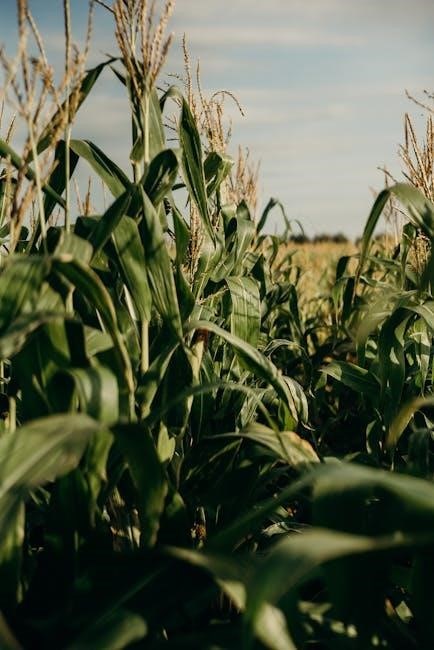Article Plan: La Paradoja Vegetal PDF Gratis
This article will guide you through “La Paradoja Vegetal,” exploring its core concepts. We’ll explore the availability of the book in PDF format. Discover where to potentially find free PDF downloads online. It will give you an overview of key concepts and some criticisms.
“La Paradoja Vegetal,” or “The Plant Paradox,” is a book by Dr. Steven R. Gundry that challenges conventional wisdom regarding healthy eating. It introduces the concept of lectins, a type of protein found in many plants, as potentially harmful substances that could contribute to weight gain, digestive issues, and other health problems. Gundry suggests that many foods commonly considered healthy may, in fact, be detrimental to our well-being due to their lectin content.
The book presents a paradigm shift in how we perceive nutrition. It encourages readers to reconsider their dietary choices and explore the potential impact of lectins on their health. Gundry shares his experience as a heart surgeon. He also shares his realization that nutrition could reverse diseases. His weight loss journey inspired the creation of the program.
“La Paradoja Vegetal” has garnered attention for its novel approach and controversial claims. It suggests that avoiding lectins can lead to improved health outcomes. The book also offers a dietary plan that focuses on lectin-free foods. It encourages readers to make informed choices about their diet. This is to potentially mitigate the negative effects of lectins. The book has sparked debate among nutritionists and health experts.
The Central Argument: Lectins and Their Impact
The core argument of “La Paradoja Vegetal” revolves around lectins. These are plant-based proteins that, according to Dr. Gundry, can have detrimental effects on human health. The book posits that lectins act as “antinutrients”. They interfere with nutrient absorption and disrupt the gut microbiome. This can lead to inflammation, weight gain, and various chronic diseases.
Gundry claims that lectins are a defense mechanism for plants. They protect them from being consumed by insects and animals. When humans ingest lectins, they can trigger an immune response. This is because the body recognizes them as foreign invaders. This immune response can manifest as inflammation. It can also manifest as digestive problems and other health issues.

The book highlights that lectins are found in a wide variety of foods. This includes grains, legumes, nightshade vegetables, and certain fruits. Gundry argues that the prevalence of these foods in modern diets contributes to the rise of chronic diseases. He advocates for a lectin-free or lectin-reduced diet to mitigate these potential health risks.
The impact of lectins extends beyond just the digestive system. Gundry suggests they can contribute to leaky gut syndrome. This allows toxins and undigested food particles to enter the bloodstream.
Steven R. Gundry: The Author and His Background
Dr. Steven R. Gundry is the author of “La Paradoja Vegetal.” He is a former cardiac surgeon who has transitioned into a proponent of alternative medicine and nutritional approaches to health. His background in conventional medicine gives him a unique perspective. It allows him to bridge the gap between traditional medical practices and novel dietary theories.
After years as a practicing surgeon, Gundry became increasingly interested in the role of nutrition in preventing and reversing disease. He observed that many of his patients could improve their health outcomes through dietary changes. This led him to research and develop his own dietary protocols. These protocols are centered around reducing inflammation and supporting the gut microbiome.
Gundry’s personal experiences also played a role in shaping his views. He claims to have experienced significant weight loss and health improvements by adopting his own dietary recommendations. This personal success further fueled his passion for sharing his knowledge with others. He established the Center for Restorative Medicine. There he focuses on treating patients with diet and lifestyle modifications.
His work and theories have garnered attention. He has received both praise and criticism from the medical community.
Availability of “La Paradoja Vegetal” in PDF Format
“La Paradoja Vegetal,” like many popular books, has seen its availability expand into various formats. These formats include physical copies, e-books, and audiobooks. The PDF format is particularly sought after by readers. They want the convenience of accessing the book on multiple devices.
Finding a legitimate PDF version of “La Paradoja Vegetal” can be challenging. Copyright laws protect intellectual property. Distributing unauthorized copies is illegal. Authorized vendors, such as online bookstores and the publisher’s website, are the best sources. They offer the official digital version.

However, some websites may offer free PDF downloads. Exercising caution is vital when using these sources. Downloading from unverified sites can expose users to malware or low-quality scans. Some sources may even be incomplete versions of the book.
It’s also worth noting that the Spanish edition of “La Paradoja Vegetal” (“La Paradoja Vegetal: Los peligros ocultos en los alimentos ‘saludables’ que provocan enfermedades y ganancia de peso”) is available as an e-book. It can be purchased through platforms like Google Play Books. This provides a convenient and legal way to access the book digitally.
Where to Find Free PDF Downloads

The quest for free PDF downloads of “La Paradoja Vegetal” often leads readers to explore various corners of the internet. However, it’s crucial to approach such searches with caution and awareness. Several websites claim to offer free e-books. Many of these sources may not be legitimate or safe.
Reputable platforms rarely provide copyrighted material for free. Websites offering “free” PDFs may be engaging in copyright infringement. Downloading from such sources can have legal consequences. Users might face penalties for obtaining or distributing unauthorized copies of the book.
Moreover, many of these sites are notorious for hosting malware, viruses, and other malicious software. Downloading a PDF from an untrusted source can compromise your device and personal information; It’s essential to prioritize your online safety and security. Only download files from verified and trustworthy websites.
Instead of risking illegal downloads, consider exploring alternative options. Libraries often offer e-book lending services. You can borrow a digital copy of “La Paradoja Vegetal” for a limited time. Another option is to check for promotional offers or discounts on the official e-book version. This is available through authorized retailers. This ensures you get a safe, legal, and high-quality reading experience.
Overview of Key Concepts in the Book
“La Paradoja Vegetal” introduces readers to the concept of lectins. These are plant-based proteins found in many foods, including grains, fruits, and vegetables. The book argues that lectins can be harmful to human health. They can contribute to inflammation, weight gain, and various chronic diseases.
Dr. Gundry proposes that lectins act as “antinutrients”. They interfere with nutrient absorption and disrupt the gut microbiome. This disruption leads to leaky gut syndrome. It allows toxins and undigested food particles to enter the bloodstream, triggering immune responses.
The book challenges conventional wisdom about healthy eating. It suggests that certain foods commonly considered healthy, such as whole grains, beans, and some vegetables, are actually detrimental due to their high lectin content.
“La Paradoja Vegetal” promotes a dietary approach that minimizes lectin consumption. This involves avoiding or limiting specific foods. These foods include wheat, corn, soy, nightshade vegetables, and certain legumes. The diet emphasizes consuming lectin-free or low-lectin foods. These include leafy greens, cruciferous vegetables, avocados, and certain types of nuts and seeds.
The book also highlights the importance of gut health and the role of prebiotics and probiotics in supporting a healthy microbiome. It encourages readers to adopt lifestyle changes. These changes can reduce inflammation and improve overall well-being.
Foods to Avoid According to “La Paradoja Vegetal”
According to “La Paradoja Vegetal,” several foods should be avoided or significantly limited due to their high lectin content. These foods are believed to contribute to inflammation and health problems. One of the primary groups to avoid is grains, particularly those containing gluten. This includes wheat, barley, rye, and other gluten-containing grains. Corn, a staple in many diets, is also discouraged.
Legumes, such as beans, lentils, and peas, are another category of foods to limit. Soy products, including tofu and soy milk, are also included in this list. Nightshade vegetables, like tomatoes, potatoes, eggplants, and peppers, are also flagged due to their lectin content.
Certain fruits, particularly those with seeds, are also discouraged. These include cucumbers, pumpkins, and squashes. Processed foods and those high in sugar are generally discouraged. They are often high in lectins and contribute to inflammation.
The book suggests that conventional dairy products should be avoided. They contain A1 casein, which is considered inflammatory. Instead, goat or sheep milk products are recommended. Certain oils, such as vegetable oils, are also discouraged due to their processing methods.
By avoiding or limiting these foods, “La Paradoja Vegetal” aims to reduce lectin consumption. This, in turn, helps to improve gut health and reduce inflammation.
Foods Recommended in “La Paradoja Vegetal”
“La Paradoja Vegetal” emphasizes consuming foods low in lectins and beneficial for gut health. The diet encourages a high intake of leafy green vegetables such as spinach, kale, and romaine lettuce. These are nutrient-dense and low in lectins. Cruciferous vegetables like broccoli, cauliflower, and Brussels sprouts are also recommended.
The book promotes the consumption of specific types of healthy fats. Avocados, olive oil, and coconut oil are highlighted for their beneficial properties. The diet includes moderate amounts of animal protein. Grass-fed beef, wild-caught fish, and pasture-raised poultry are preferred options.
Certain resistant starches, like sweet potatoes and taro, are also encouraged. They provide energy and support gut health. Specific fruits that are low in lectins are allowed in moderation. Examples include berries and citrus fruits.
The diet emphasizes the importance of fermented foods like sauerkraut and kimchi. They support a healthy gut microbiome. Goat and sheep milk products are preferred over cow’s milk due to the different types of casein. Specific nuts and seeds, like walnuts and macadamia nuts, are also recommended.
By focusing on these foods, “La Paradoja Vegetal” aims to reduce inflammation. It also supports a healthy gut and promotes overall well-being.
Criticism and Reception of the Book
“La Paradoja Vegetal” has garnered both praise and criticism since its publication. Some nutritionists and health experts have lauded the book. They cite its novel approach to diet and health. Some experts agree that reducing lectins can alleviate certain health issues. Many people who have followed the diet report positive outcomes.
However, the book has also faced substantial criticism from the scientific community. Many experts argue that the claims about lectins are overblown. They cite that lectins are only harmful in very high concentrations. They also mention that cooking often deactivates lectins in food. Concerns have been raised about the restrictive nature of the diet.
Critics argue that eliminating many healthy foods could lead to nutrient deficiencies. They also note that the book relies heavily on anecdotal evidence. There is a lack of robust scientific studies to support all of its claims. The book’s popularity has led to a polarized reception.
While some readers praise it for improving their health. Others dismiss it as pseudoscience. The debate surrounding “La Paradoja Vegetal” highlights the complexities of nutritional science. It also shows the challenges of translating research into dietary advice.
Scientific Evidence Supporting the Book’s Claims
The scientific evidence supporting the claims made in “La Paradoja Vegetal” is a complex and debated topic. Steven Gundry bases his arguments on the potential harmful effects of lectins. Lectins are a type of protein found in many plants. Some studies suggest that certain lectins can interfere with nutrient absorption.

They can also promote inflammation in the gut. Gundry argues that these effects contribute to a wide range of health problems. These problems include weight gain, digestive issues, and chronic diseases. Some research has investigated the impact of specific lectins on the body.
For example, studies have examined the effects of wheat germ agglutinin (WGA) on intestinal health. However, the evidence is often limited. Many studies are conducted in vitro or on animals. It is difficult to extrapolate these findings to humans.
Additionally, many traditional cooking methods reduce lectin content in foods. Methods like soaking, sprouting, and fermenting can neutralize lectins. Critics argue that the book overstates the dangers of lectins. They say that a balanced diet with varied food preparation can mitigate risks.
Further research is needed to fully understand the role of lectins in human health. More studies are needed to determine the long-term effects of a lectin-restricted diet.
Is “La Paradoja Vegetal” Worth Reading?
Whether “La Paradoja Vegetal” is worth reading depends on individual perspectives and health goals. The book presents a unique and somewhat controversial perspective on nutrition. It challenges conventional wisdom about healthy foods. Gundry’s emphasis on lectins and their potential impact on health is thought-provoking.
Readers who are open to alternative dietary approaches may find it intriguing. However, it’s essential to approach the book with a critical eye. The scientific evidence supporting some of the claims is still evolving. It is important to consider alternative perspectives.
The book may be valuable for those struggling with unexplained health issues. It may also appeal to those seeking to optimize their diet. It encourages readers to be more mindful of their food choices. The book prompts reflection on potential sensitivities.
However, it’s crucial to consult with healthcare professionals. It’s important to discuss any significant dietary changes, especially if you have underlying health conditions. A balanced and personalized approach to nutrition is always recommended.
Ultimately, “La Paradoja Vegetal” can be a valuable resource for expanding your knowledge of nutrition. The readers can use it as a jumping-off point for further research. However, it should not replace professional medical advice.

